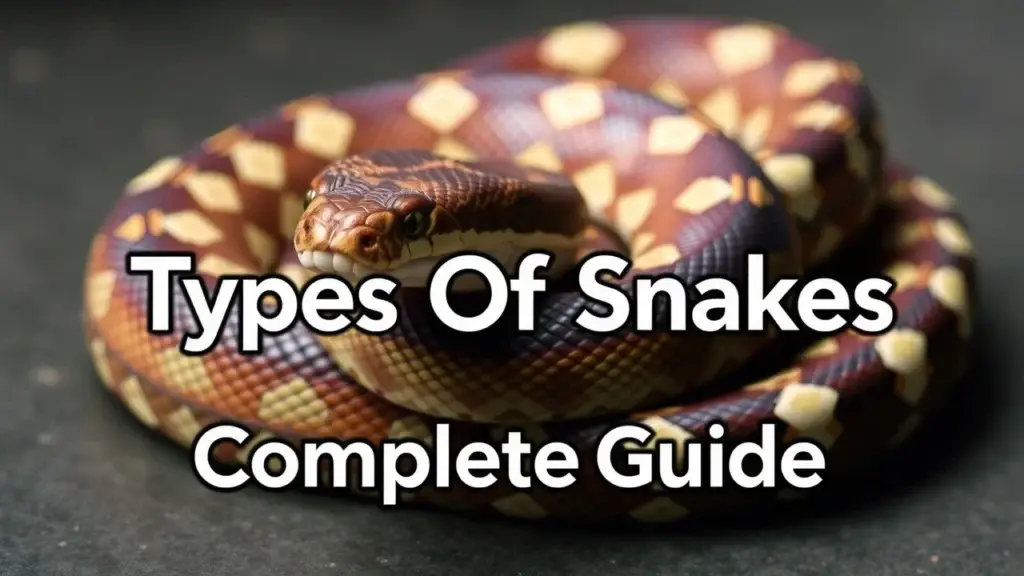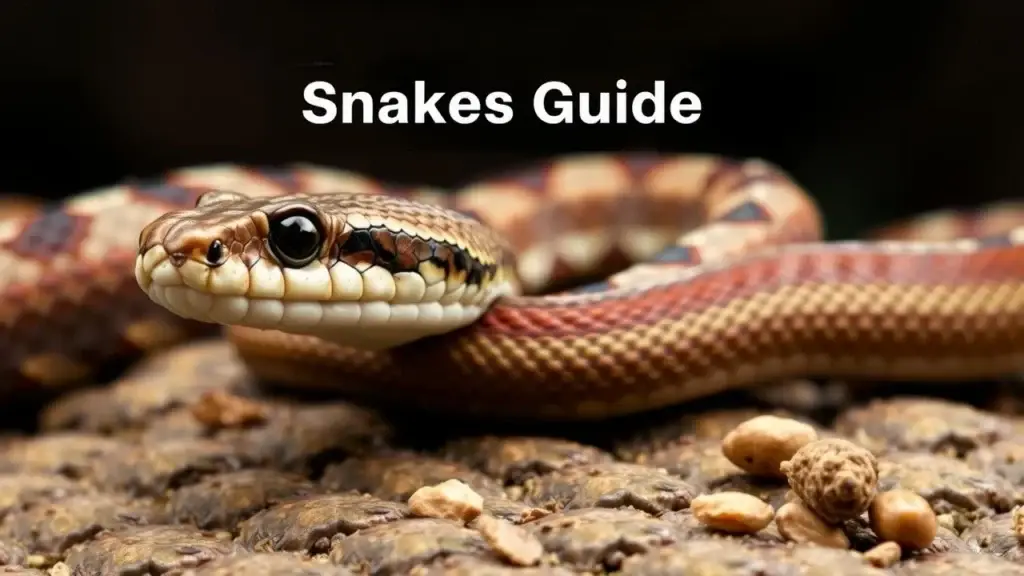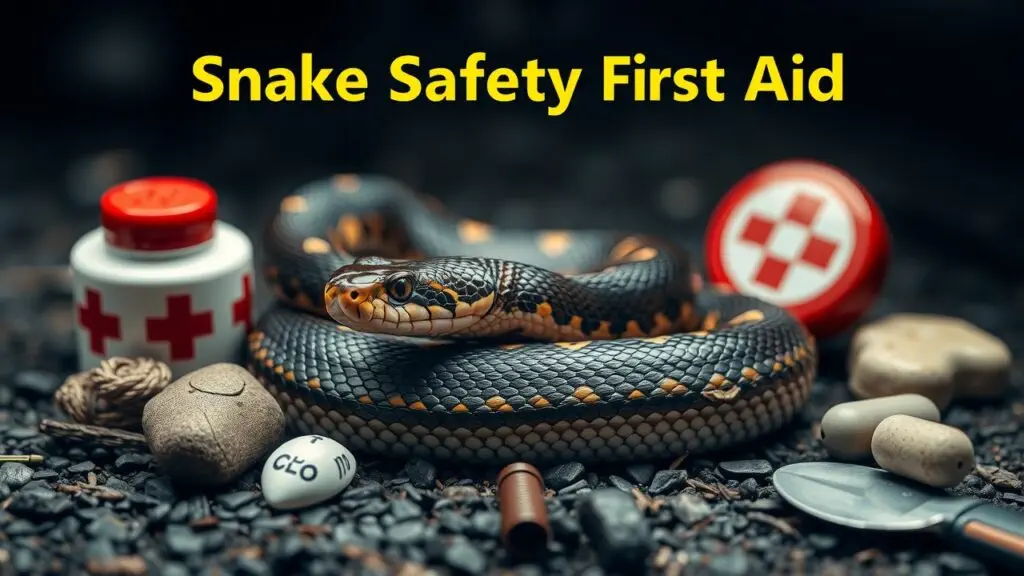Learn about different types of snakes, from venomous cobras to non-venomous pythons. This guide covers identification, behavior, and habitats worldwide.
What Are Snakes?

Snakes are cool reptiles that belong to a group called Serpentes. They have some special traits that make them different from other reptiles. One major thing is they don’t have legs! Instead, they move with their long bodies and special muscles. Their skin is covered in scales, which help keep them safe and stop water from leaving their bodies.
Key Physical Characteristics
- Scaly Skin: Snake skin has lots of overlapping scales that protect them and help with movement.
- Legless Body: Snakes are totally legless, which lets them slither easily in many places.
- Elongated Form: They can be really long! Some snakes are only a few inches, while others can be over 20 feet long, depending on the kind.
By knowing these features, we can see how different types of snakes are.
Why Is It Important to Learn About Snake Types?
Learning about snake types is super helpful for a bunch of reasons:
- Safety: Knowing the difference between venomous and non-venomous snakes helps keep you safe from dangerous bites.
- Ecosystem Role: Snakes are important in nature because they help control pests and keep food chains balanced.
- Pet Ownership: If you want to keep a snake as a pet or just watch them in the wild, knowing about different species can make you a better owner or observer.
When we learn about snake biodiversity, it helps us support efforts to protect these amazing animals.
How Are Snakes Classified?
Snakes are put into groups based on different things like whether they have venom, where they live, what they eat, and how they look. Here’s a quick look at how they’re classified:
| Classification Criteria | Description |
|---|---|
| Venom Presence | Snakes can be venomous (like cobras) or non-venomous (like garter snakes). |
| Habitat | Some snakes like forests while others enjoy deserts or water. |
| Diet | Most snakes eat meat but their meals vary; some eat rodents while others feast on fish or frogs. |
| Anatomy | They come in different shapes—some are thin while others like pythons are much thicker. |
This way of classifying helps experts study snake behavior and environment better and gives fans more info about specific kinds of snakes.
Major Families of Venomous Snakes
Elapidae Family (Cobras, Mambas, Coral Snakes)
What Makes Elapids Unique?
Elapids are a special group of snakes with strong neurotoxic venom. This venom can mess with the nervous system, causing paralysis or even death if not treated. A cool thing about elapids is that they have fixed front fangs. These help them inject venom deep into their prey. Unlike some snakes that hide and wait, elapids are more like active hunters.
Examples
Here are some well-known elapids:
- King Cobra: The longest venomous snake around! It’s really big and has a super strong bite.
- Black Mamba: This snake is fast and its venom is deadly. It strikes quickly if it feels threatened.
- Eastern Coral Snake: With bright colors and a unique pattern, this snake has a strong bite but it rarely causes death.
Habitat & Diet
Elapids can be found in many places like forests and savannas. They eat small mammals, birds, and reptiles. When they hunt, they strike quickly and then wait for their prey to feel the effects of the venom before eating.
Viperidae Family (Vipers and Pit Vipers)
Defining Features
Vipers have a distinct triangular head shape. Their long fangs fold back when not in use, making them easier to hide. Many vipers also have special heat-sensing pits between their eyes and nostrils. These help them find warm-blooded prey even in the dark. Their hemotoxic venom can damage tissues near the bite site as well as affect blood cells.
Examples
Common vipers include:
- Timber Rattlesnake: Known for its rattle at the tail end, it warns other animals when it feels danger.
- Copperhead: This snake has a coppery color and is often found in wooded areas across North America.
- Gaboon Viper: It stands out because it has the longest fangs of any snake! Plus, it has a beautiful pattern on its skin.
Habitat & Diet
Vipers live in many environments like forests and deserts. They usually hunt rodents and small mammals by staying still until an unsuspecting animal gets close enough for a quick strike.
Major Families of Non-Venomous Snakes
Colubridae Family (Rat Snakes, Garter Snakes)
The Colubridae family is the biggest group of snakes in the world. Most colubrids are harmless, which means they won’t hurt you. But some rear-fanged colubrids can bite and have a mild venom that isn’t dangerous.
Characteristics
Colubrids come in many shapes, sizes, and colors. This variety makes them interesting to see. Most don’t threaten people; they depend on being fast or hiding to stay safe instead of using venom.
Examples
Here are some common colubrid examples:
- Corn Snake: A friendly pet known for its beautiful colors.
- Eastern Garter Snake: Found in many places across North America like gardens and wetlands.
You can recognize these snakes by their unique patterns that help them blend into their surroundings.
Habitat & Diet
Colubrid snakes like to live in gardens, grasslands, forests, and even cities. They usually eat small animals like mice and frogs. This diet helps keep pests under control both in nature and around human homes.
Boidae Family (Boas and Pythons)
The Boidae family includes some of the largest non-venomous snakes called constrictors. These snakes, which include boas and pythons, use special ways to catch their food without venom.
Key Traits of Constrictors
Boas and pythons catch their food by wrapping around it tightly—that’s called constriction. When they grab an animal, they squeeze until it can’t breathe anymore before swallowing it whole. This method lets them hunt animals much bigger than themselves without needing venom.
Examples
Here are two popular boids:
- Ball Python: Great as a pet because it’s usually calm and only grows about 3–5 feet long.
- Burmese Python: While also kept as pets, these snakes get really big—up to 20 feet long! They need a lot of space which not everyone can provide safely.
Both types show different behaviors but often share similar habitats even with size differences.
Geographic Distribution & Diet
Boas mostly live in Central America while pythons are found in warm places all over the world like Africa and Asia. Both families prefer tropical areas where they can find enough food like rodents or birds. Knowing where these fascinating snakes live helps us understand their role in nature around the world.
What Is the Difference Between Venomous and Non-Venomous Snakes?
When you learn about snakes, it’s super important to know the difference between venomous snakes and non-venomous snakes. This knowledge helps you figure out what kind of snake you’re looking at and how to act if you see one in the wild.
Venomous snakes have special glands that create venom. They use this venom mainly to catch prey or protect themselves. This venom can be very harmful or even deadly to people. Non-venomous snakes don’t have these glands. Instead, they may use other methods like squeezing their prey or swallowing it whole.
Comparison by Fang Structure
| Feature | Venomous | Non-Venomous |
|---|---|---|
| Fang Type | Hollow fangs | No specialized fangs |
| Head Shape | Often triangular | Rounded |
| Hunting Mechanism | Injection via bite | Constriction / swallowing |
Venomous snakes usually have hollow fangs. These fangs let them inject venom into their prey when they bite. Some have front fangs, while others have rear fangs that also work to deliver venom.
Non-venomous snakes don’t have hollow fangs. They might have teeth for holding onto their food instead. They often catch their meals by wrapping around them until they can’t breathe or just swallowing them whole.
Types of Venom
There are different kinds of venoms in various snake species. Each type has special components that help them take down their prey:
- Neurotoxins: These mess with the nervous system and can make a victim paralyzed.
- Hemotoxins: These harm blood cells and tissues, causing bleeding inside.
- Cytotoxins: These destroy cells right where the bite happens.
Knowing about these different venoms helps explain why some bites are way more dangerous than others.
Common Misconceptions
Many folks mix up “poison” with “venom.” Poison is something bad for you if you eat it or touch it, while venom needs to be injected through a bite or sting to work its magic. This confusion leads to silly myths about harmless snakes being called poisonous when they’re really just non-venomous.
By learning how to spot the differences between types of snakes—especially whether they’re venomous—you’ll feel more prepared when you’re out in nature!
Regional Identification Guide Of Famous Local Examples Globally

North American Snakes
North America has many snake species. Some are venomous, while others are not. Here are a few you might find:
- Rattlesnakes: Known for their rattle, these snakes warn you before they strike. They prefer rocky places.
- Garter Snakes: You can often spot these harmless snakes in gardens. They have stripes that make them easy to identify.
- Corn Snakes: These non-venomous snakes have pretty patterns. They like to hang out in fields or forests.
- Eastern Hognose Snake: This snake has a funny nose that helps it dig. It’s mostly harmless but can act tough when scared.
Each of these snakes has its favorite home. For example, garter snakes enjoy wetlands and grassy areas, while rattlesnakes like rocky spots.
European Snakes
Europe has some interesting snakes too! Here are a few you might see:
- European Adder: This is the only venomous snake in Britain. It has a zigzag pattern that helps it hide in the woods.
- Grass Snakes: These guys love water! They’re great swimmers and eat frogs and fish.
- Smooth Snake: This rare snake likes heaths and can blend in easily because of its smooth scales.
It’s really important to know which snakes are around. Some can be dangerous, so being able to identify them keeps you safe outdoors.
Asian Snakes
Asia is home to some famous and big snakes:
- Cobras: You might know them for their hoods. When threatened, they show this hood and can be very dangerous.
- Burmese Python: This is one of the biggest snakes you’ll find anywhere! It lives in tropical forests and eats all kinds of animals.
- King Cobra: This snake is super long, reaching over 18 feet! They mainly eat other snakes and like to live in healthy forest areas.
These snakes play important roles in nature by keeping animal populations balanced and sometimes interacting with humans when their habitats overlap.
African Snakes
Africa has a wide range of unique snakes.
Black mambas are scary due to their speed and venom. Gaboon vipers are hard to spot because they blend into leaves on the ground!
Knowing where these snakes live helps protect them from losing their homes because of human activities across Africa.
Australian Snakes
Australia is famous for its dangerous snakes:
- Eastern Brown Snake: This snake is very aggressive but also very venomous. It’s one of the most dangerous land snakes around!
- Taipans: These include several types like the coastal taipan, known for quick strikes when feeling threatened!
When you’re outside, be careful! Keep your distance from these snakes if you see them to stay safe while enjoying nature in Australia’s unique wildlife areas.
Snake Identification: Key Features and Techniques
Identifying snakes can be fun but tricky. Knowing the key features of different types of snakes helps everyone from animal lovers to pet owners. Snakes belong to various families based on traits like body shape, behavior, habitat, and what they eat. The main categories to remember are venomous and non-venomous snakes.
Visual Identification Guide
To identify a snake by sight, look for these important features:
- Coloration: Different snakes have unique color patterns that help with identification.
- Body Shape: Some snakes are skinny while others are thicker.
- Head Shape: Venomous snakes usually have triangular heads. Non-venomous snakes often have rounder heads.
- Scale Texture: Some scales feel smooth while others might feel rough.
Here’s a table showing some common traits between harmless and venomous snakes:
| Feature | Harmless Snakes | Venomous Snakes |
|---|---|---|
| Head Shape | Rounded | Triangular |
| Eye Pupil | Round | Slit-like |
| Color Patterns | Varied but often duller | Brightly colored |
| Tail | Tapered | Often blunt |
Geographic Variations within Species
Snakes look different depending on where they live. A species in one area might have different colors or sizes than the same species in another place. This happens because of factors like climate or food sources. Learning about local populations helps with accurate identification.
Safe Identification Practices
When looking at snakes in nature, keep safety in mind:
- Avoid touching them unless you know what you’re doing; not everyone can tell safe from dangerous snakes.
- Use binoculars to watch them from far away without bothering them.
- If you see a snake that needs help, call wildlife experts instead of trying to catch it yourself.
Snake Habitats and Conservation
Snake Habitats and Geographic Distribution
Snakes are really cool animals that live in many different places around the world. Learning about their habitats helps us understand why they matter and how to keep them safe. Snakes can be found in four main types of habitats: arboreal, terrestrial, aquatic, and fossorial.
Arboreal snakes live in trees or bushes. They are good climbers and sometimes have special tails to help them hold on. A common example is the green tree python, which lives in the rainforests of New Guinea and Australia.
Terrestrial snakes spend most of their time on land. You can find them in grasslands, deserts, and forests. The eastern garter snake is a popular one that lives all over North America.
Aquatic snakes are those that love water. They like to hang out in rivers, lakes, or swamps. The common water snake is a familiar sight in many wetlands across North America.
Finally, fossorial snakes are made for digging. They can move easily underground because their scales are smooth. A good example of this type is the Eastern hognose snake, which prefers sandy places.
Here’s a quick look at where these snakes are found:
- Rainforests: Lots of arboreal species live here.
- Grasslands: Many terrestrial snakes make these areas their home.
- Wetlands: Aquatic snakes depend on these ecosystems.
- Deserts: Terrestrial snakes here have special features to survive.
Knowing where different types of snakes live helps us appreciate the rich biodiversity around us.
Impact of Habitat Loss on Snake Populations
Habitat loss is a big problem for snake populations everywhere. When cities grow, they often take over natural areas where snakes live. Farming and logging also hurt these habitats, making it hard for snakes to survive.
Keeping our natural environments safe is key to protecting not just snakes but many other animals too. Each type of habitat supports different species with unique needs. If we lose these places, many animals could disappear as well.
There are many efforts underway to help endangered snake species by restoring their homes and creating protected spaces for them. Groups are working hard to teach communities about using land responsibly while stopping harmful activities that threaten local wildlife.
In short, learning about where snakes live and how humans affect these habitats reminds us of our role in helping protect these amazing creatures for future generations.
Snake Safety and First Aid

Being safe around snakes is really important. Whether you love learning about them or have a pet snake, knowing how to spot different types of snakes and handle them can keep you safe.
Safe Handling Practices
When you want to handle non-venomous snakes or rear-fanged ones that might bite, follow these easy rules:
- Wash your hands before and after handling.
- Use both hands to support the snake’s body.
- Move slowly so you don’t startle it.
- Don’t try to handle wild snakes; they can be unpredictable.
These tips help keep both you and the snake safe.
First Aid for Snakebites
If a venomous snake bites you, getting help fast is very important. Here’s what to do:
- Call for help right away.
- Stay calm and keep the bitten area still and low.
- Don’t use ice or tight bandages; they can cause more harm.
- Antivenom might be needed depending on the bite.
Knowing these first aid steps can be life-saving after a bite from a venomous snake.
Frequently Asked Questions (FAQs) about Types of Snakes
What are the main types of snakes?
Snakes fall into several categories. The most common are venomous and non-venomous snakes. Within these categories, you can find families like elapids, vipers, colubrids, and boids.
How do I identify different snake species?
To identify a snake, observe its coloration, body shape, head shape, and scale texture. This helps you tell venomous snakes from non-venomous ones.
What are some common venomous snakes?
Common venomous snakes include the king cobra, eastern diamondback rattlesnake, and black mamba. These snakes have potent venom that can be dangerous to humans.
Are there non-venomous snakes I should know about?
Yes! Common non-venomous snakes include corn snakes, garter snakes, and rat snakes. These snakes are harmless and often make great pets.
How do habitats affect snake populations?
Different habitats support various snake species. Snakes thrive in environments like forests, grasslands, and wetlands. Each habitat provides unique resources for survival.
What is snake ecology?
Snake ecology studies how snakes interact with their environment. It includes their roles as predators and prey within ecosystems.
How does human activity impact snake conservation?
Human activities such as habitat destruction threaten snake populations. Conservation efforts aim to protect their habitats and ensure their survival.
Additional Keywords Related to Types of Snakes
- Snake Morphology: Study of snake body structure.
- Snake Taxonomy: Classification system for different snake species.
- Snake Distribution: Geographic range of various snake types globally.
- Snake Preservation: Efforts to protect endangered snake species.
- Snake Behavior: Insights into feeding habits and mating rituals.
- Venom Components: Neurotoxins, hemotoxins, myotoxins found in different venoms.
- Ecological Role: Importance of snakes in maintaining ecological balance.
- Venomous Snake Identification: Key traits to recognize venomous species.
- Biodiversity Significance: Importance of preserving diverse snake populations.
Related Topics
- Types of venomous snakes
- Types of non-venomous snakes
- Types of snake habitats
- Types of snake venom
- Types of snake identification techniques
- Types of snake handling practices
- Types of snake first aid
- Types of snake conservation efforts
- Types of snake families
- Types of snake diets
- Types of snake head shapes



Types of Snakes: A Complete Guide to Snake Species, Habitats, and Behavior